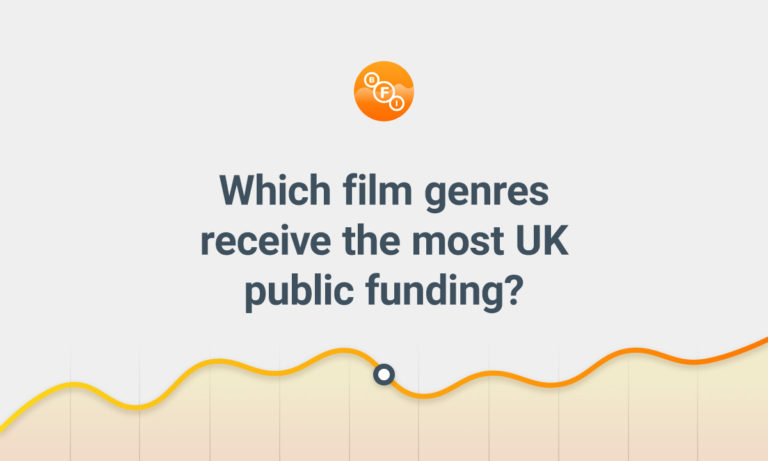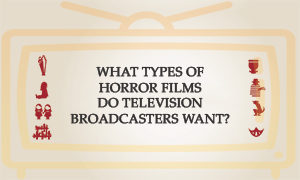 When new filmmakers think about their movie reaching audiences, they tend to picture its cinema release, or maybe what it will look like when it hits DVD shelves. Few fantasise about their movie’s first ever television broadcast.
When new filmmakers think about their movie reaching audiences, they tend to picture its cinema release, or maybe what it will look like when it hits DVD shelves. Few fantasise about their movie’s first ever television broadcast.
Despite this, television is the largest source of revenue for movies. This means that the total amount paid by broadcasters to licence movies is greater than the amount filmmakers earn from the theatrical release (i.e. cinemas), greater than all the money earned via video on demand platforms (i.e. iTunes and Netflix) and greater even than Home Entertainment revenues (i.e. DVDs and Blu-Ray).
Even if it’s not possible to get the granular level of detail we are used to from cinemas, filmmakers should do all they can to understand the tastes and desires of television broadcasters.
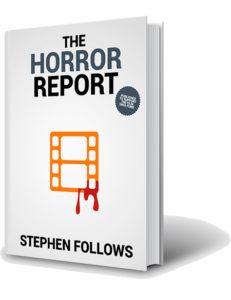 I recently looked at this topic in relation to horror movies. The research was part of an eighteen-month project I conducted studying all aspects of horror movies. The final result is a 200+ page report into all aspects of horror movies. You can learn more and grab your own copy at stephenfollows.com/horrorreport
I recently looked at this topic in relation to horror movies. The research was part of an eighteen-month project I conducted studying all aspects of horror movies. The final result is a 200+ page report into all aspects of horror movies. You can learn more and grab your own copy at stephenfollows.com/horrorreport
As part of the Horror Report work, I teamed up with Essential Television Statistics, which tracks broadcasts of feature films around the world. ETS provided me with a dataset of 84,890 horror film screenings in a five-year period (2011-15), across 442 TV channels in 36 countries. See the notes at the end of this article for more detail on the dataset.
This huge amount of data was enough for me to get an insight into what types of horror films perform well on television channels around the world.
What are the most frequently broadcast horror movies?
The dataset included 2,907 horror movies, with each receiving an average of just over 29 screenings around the world during the period studied. However, some films were broadcast far more often than others. The most frequently-screened film during this period was Resident Evil: Apocalypse, which received a whopping 866 screenings.
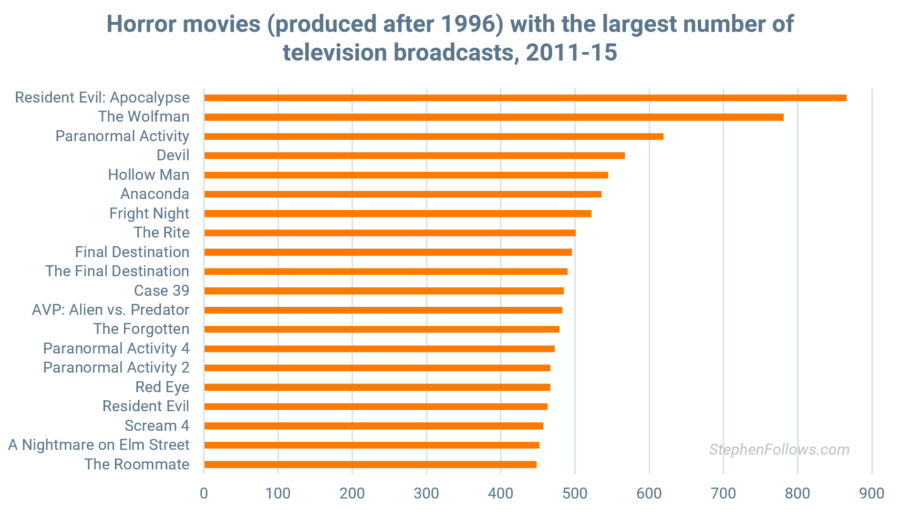
What percentage of horror movies received a television broadcast?
As part of the research I conducted for another section of the Horror Report, I built up a database of all horror movies ever made. This meant that I was able to look at how many of those films were broadcast on television over the five-year period I studied.
The proportion of horror films broadcast on international television has gradually increased over the last four years. The graph below illustrates the percentage of horror films that were made in any one year and went on to be broadcast on television at least once between 2011 and 2015.
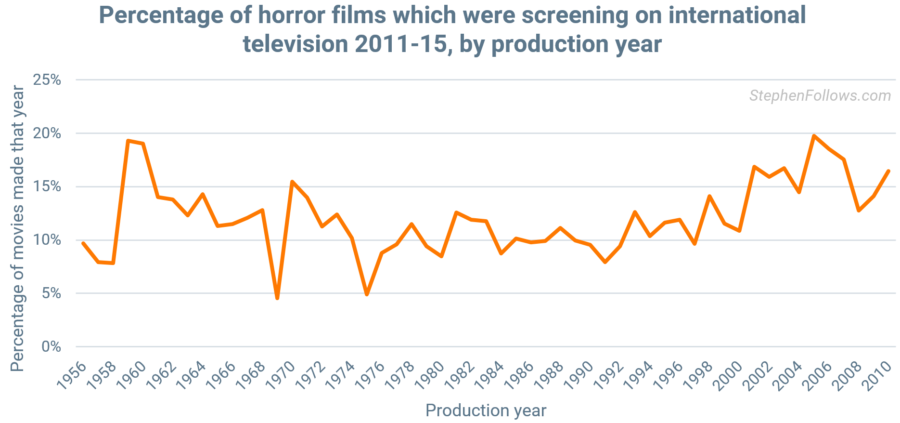
Budgets of horror movies broadcast on TV
If we compare the details of the types of horror films made with the types of horror movies shown on television, we can see some stark differences.
The lowest budget range of horror movies, those made on under $1 million, account for 55% of horror movies made (1996 to 2010) but only 12% of these horror films were broadcast in the following five years (i.e. 2011 to 2015). Moving up the budget range, there is an increased chance that these films will secure a television broadcast.
Films budgeted between $1 million to $25 million represent 37% of movies made, but account for almost 70% of broadcasts. Films costing between $25 million and $50 million represent 5% of production and 11% of broadcasts. Finally, films costing over $50 million represent 3% of films made and 7% of films broadcast.
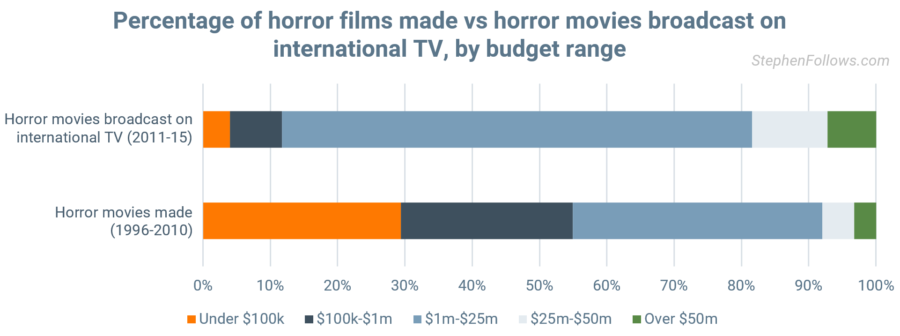
Another way at looking at the data is to see what percentage of movies made in each budget range reached television screens.
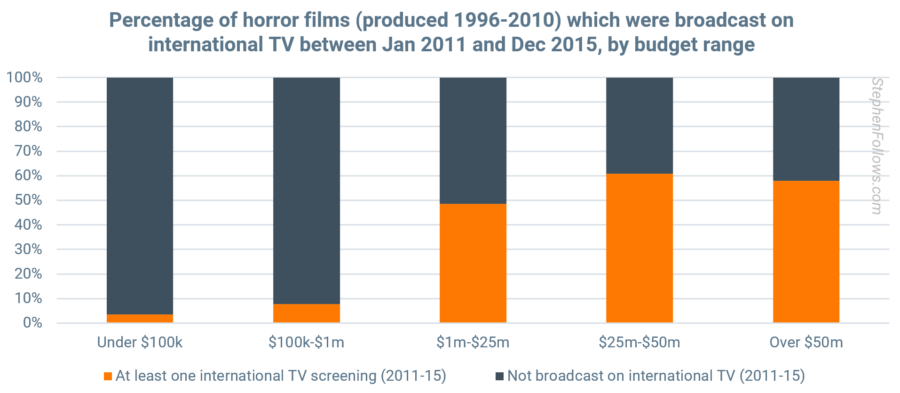
Bear in mind that this data is only looking at a five-year window of broadcasts. Some films listed as not being broadcast could have been scheduled either before or after this study period.
Types of horror movies broadcast on TV
As part of the Horror Report research, I built a classification system which grouped horror movies into six different types. Films could appear in more than one category, although most did not. By using this lens, we can see that there is a difference between the kinds of movies filmmakers make and the types of movies broadcast on television.
Psychological horror movies are more popular with broadcasters by comparison with the quantity made (they represent 4% of all horror movies made, but 7% of all horror movies broadcast), which is most likely due to the relatively lower censor rating Psychological films are likely to have. Monster films are distinctly unpopular, making up 24% of horror movies made, but fewer than 17% of horror movies broadcast.
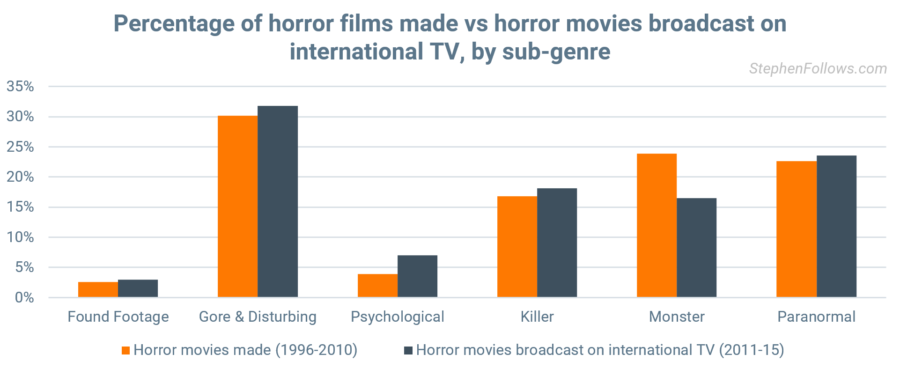
Subgenres of horror movies broadcast on TV
In another chapter of the Horror Report, I was able to show that film critics preferred horror films which traditionally took a lighter approach to horror (such as horror comedies) than those with a traditionally darker approach (such as horror thrillers). Interestingly, the reverse correlation applies to the subgenres most likely to reach television screens.
Horror comedies and horror romances have the lowest chance of being broadcast, while horror thrillers and horror mysteries have the highest.
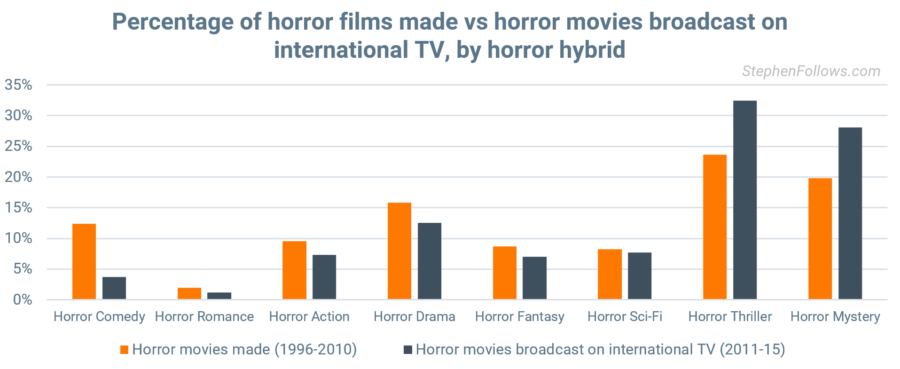
The data does not reveal why this correlation exists but it could be a result of most horror broadcasts being on dedicated horror channels, thereby creating a greater demand for ‘harder’ and ‘more pure’ horror content.
Quality of horror movies broadcast on TV
As indicated in the subgenre section, the views of film critics appear to have no impact on a horror movie’s likelihood of being broadcast on television. In fact, movies judged to be poor by critics are disproportionally better served by television schedulers than those the critics liked.
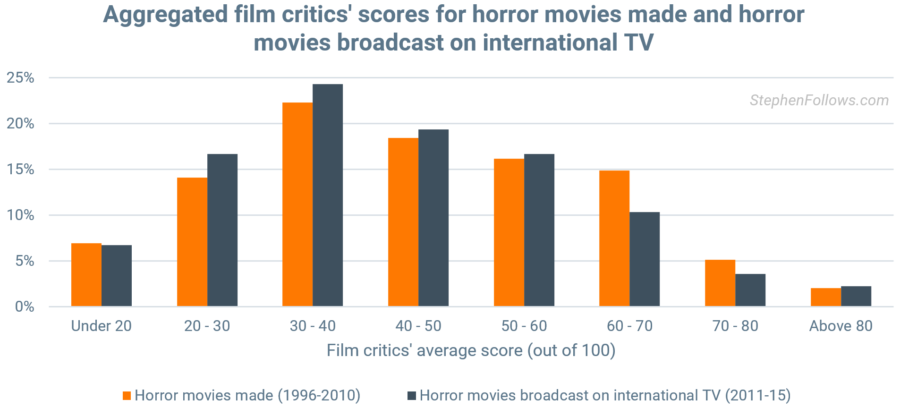
By comparison, audience scores do roughly track the likelihood of achieving a television broadcast, in that the films which audiences rated poorly are not represented on television broadcasts.
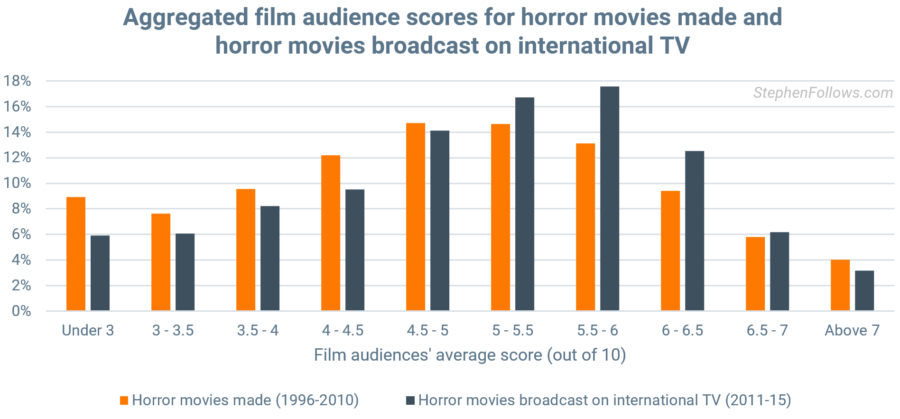
The effect of sex and violence on TV broadcasts
Elsewhere in the report, I created measures of sex and violence in horror movies (out of ten). This allowed me to look at the correlation between the films chosen for television broadcast and their content.
Television schedulers appear to disproportionately favour horror movies with what could be described as a ‘middling’ amount of sex and nudity, i.e. those rated between three and seven on a scale out of ten. Perhaps unsurprisingly, those with the highest levels of sex and nudity were much less likely to be scheduled than other horror movies.
This is likely to be down to censorship difficulties and restrictions on what times of the day such explicit content can be broadcast.
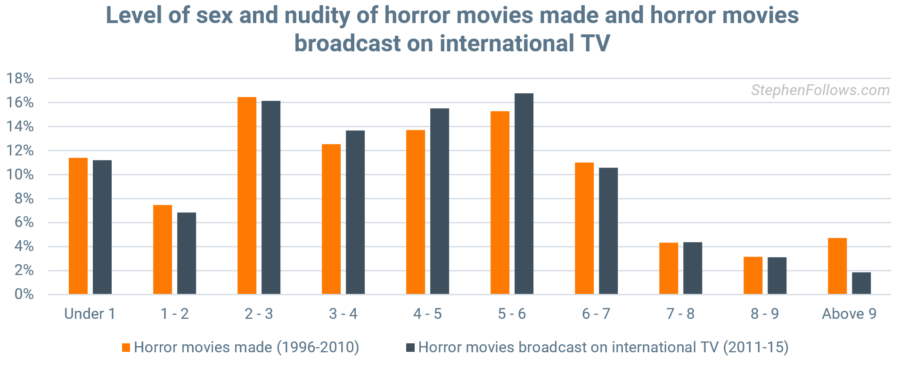
The level of violence and gore in horror movies has a similar impact. Horror movies with a rating of between three and six have a relatively high chance of being broadcast on international TV, while those rated nine and above have a substantially lower chance.
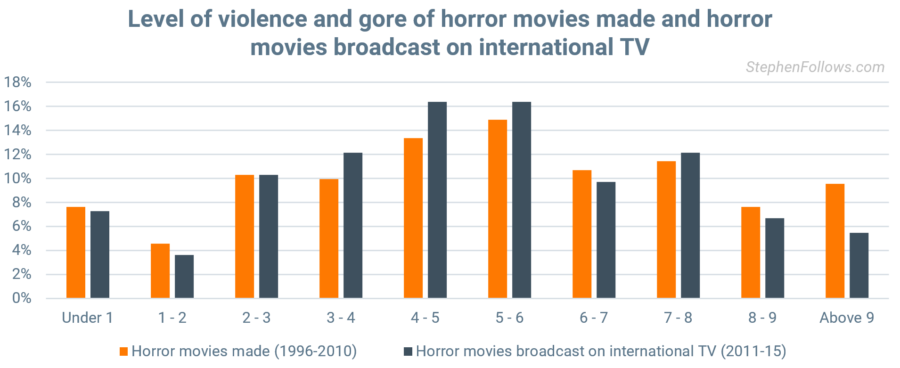
Want to read more?
 The Horror Report contains more detail of the types of horror movies screening on television, as well as covering all other aspects of the film life cycle, right from development through to profitability. The report is sold on a ‘Pay What You Can’ model, meaning that you choose the price you pay.
The Horror Report contains more detail of the types of horror movies screening on television, as well as covering all other aspects of the film life cycle, right from development through to profitability. The report is sold on a ‘Pay What You Can’ model, meaning that you choose the price you pay.
To find out more and to grab a copy of the 200+ page report, please visit stephenfollows.com/horrorreport.
Notes
Finding data for how movies perform on television is quite tricky, for a number of reasons:
- Worldwide market – There are many countries which broadcast movies on television.
- Many channels – In each, there are often many different channels.
- Private deals – Television deals are agreed in private and we don’t get the kind of data we get from the theatrical box office.
- Bundling – Even if we had sight of these deals, in many channels broadcasters will agree package deals with distributors for a collection of movies.
The data for this television research comes via Essential Television Statistics, which tracks broadcasts of feature films around the world. ETS provided me with a dataset of 84,890 horror film screenings in a five-year period (1st January 2011 to 31st December 2015), across 442 TV channels in 36 countries.
The countries included in this data are Argentina, Australia, Austria, Belgium, Brazil, Canada, Chile, Colombia, Croatia, Czech Republic, Denmark, Finland, France, Germany, Greece, Hong Kong, Hungary, Indonesia, Italy, Japan, Mexico, Netherlands, New Zealand, Norway, Pakistan, Poland, Portugal, Republic Of Ireland, Romania, Russia, South Africa, South Korea, Spain, Sweden, Switzerland and the United Kingdom. This research does not include television broadcasts in the United States.
It should be noted that this research tracks the number of screenings, rather than the amount paid, the prestige of the television channel involved or the audience watching the films. Accordingly, while the findings give a sense of what is popular with broadcasters, they cannot reveal which horror films made the most money from selling their television distribution.
There are more details of the data sources and methodology in the Horror Report.


